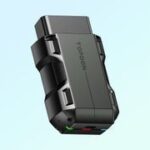Erasing trouble codes with an OBD2 scanner before an emissions test might seem like a quick fix, but it can actually backfire. This article outlines the dos and don’ts of handling your car’s OBD2 system and emissions testing, focusing on the impact of clearing codes.
Understanding Your Car’s OBD2 System and Emissions
Your car’s On-Board Diagnostics II (OBD2) system constantly monitors its emission control systems. When a problem is detected, it stores a Diagnostic Trouble Code (DTC) in its memory. These codes are crucial for diagnosing emission-related issues. An emissions test utilizes the OBD2 system to assess your vehicle’s compliance with environmental regulations.
Why Erasing Codes Before an Emissions Test is a Bad Idea
Clearing DTCs with an OBD2 scanner before an emissions test essentially wipes the OBD2 system’s memory clean. This prevents the emissions test from accessing crucial diagnostic information, leading to an automatic rejection. The test needs data logged over a certain period of driving under various conditions to accurately assess the vehicle’s emissions performance.
What to Do If Your Check Engine Light Is On
If your “Check Engine” or “Service Engine Soon” light illuminates, address the underlying issue immediately. A flashing light signals a potentially serious problem that could damage your catalytic converter, a costly component to replace.
Do:
- Get it diagnosed: Take your vehicle to a qualified mechanic to diagnose and repair the problem causing the Check Engine light.
- Check your gas cap: A loose or faulty gas cap is a common culprit. Ensure it’s properly tightened.
- Check warranty/recall information: Contact your dealer to see if the issue is covered. Emission components often have extended warranties.
- Allow driving time after repairs: After repairs or battery replacement, drive your car for a week under varied conditions to allow the OBD2 system to re-learn and log necessary data.
Don’t:
- Ignore the light: Ignoring a Check Engine light can lead to more severe and expensive problems.
- Drive with a flashing Check Engine Light: This indicates a serious issue that needs immediate attention.
- Erase codes right before the test: This will lead to an automatic rejection.
Preparing for Your Emissions Test
Do:
- Schedule your test early: This provides time for repairs if needed. Remember, the test results are often valid for a specific period.
- Remove any monitoring devices: Unplug devices that monitor driving habits plugged into the OBD2 port before the test.
- Consult your DMV: If you have questions or specific circumstances, contact your local DMV for guidance.
Conclusion
Erasing codes with an OBD2 scanner before an emissions test is counterproductive. It hinders the test’s ability to evaluate your vehicle’s emissions accurately, resulting in rejection. Instead of trying to bypass the system, address any underlying issues causing the Check Engine light to ensure your vehicle passes emissions testing legitimately. Focus on proper vehicle maintenance and follow recommended guidelines for a successful emissions test.

